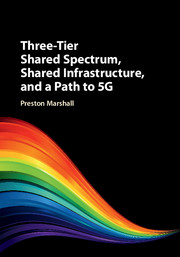Book contents
- Frontmatter
- Contents
- Acknowledgments
- Preface
- Part I Spectrum Sharing Background
- Part II Three-Tier Dynamic Spectrum Models
- Part III Components of a Three-Tier Architecture
- Part IV Protection Processes for Incumbents and Peers
- Part V Example Use of Three-Tier Spectrum: Use of the 3.5 GHz CBRS Band in the USA
- Part VI Future Bands, Network Services, Business Models, and Technology
- 15 Potential Services and Business Models Enabled by Three-Tier Spectrum
- 16 Candidate Incumbent Bands for Three-Tier Spectrum Sharing
- 17 From Shared Spectrum, to Shared Infrastructure, to a New Model of 5G
- 18 Future Actions to Deploy More Three-Tier Spectrum Bands and Nations
- 19 Alternatives to Three-Tier Operation
- 20 Conclusions and a Look Ahead
- Part VII Appendices
- Index
- References
17 - From Shared Spectrum, to Shared Infrastructure, to a New Model of 5G
from Part VI - Future Bands, Network Services, Business Models, and Technology
Published online by Cambridge University Press: 30 August 2017
- Frontmatter
- Contents
- Acknowledgments
- Preface
- Part I Spectrum Sharing Background
- Part II Three-Tier Dynamic Spectrum Models
- Part III Components of a Three-Tier Architecture
- Part IV Protection Processes for Incumbents and Peers
- Part V Example Use of Three-Tier Spectrum: Use of the 3.5 GHz CBRS Band in the USA
- Part VI Future Bands, Network Services, Business Models, and Technology
- 15 Potential Services and Business Models Enabled by Three-Tier Spectrum
- 16 Candidate Incumbent Bands for Three-Tier Spectrum Sharing
- 17 From Shared Spectrum, to Shared Infrastructure, to a New Model of 5G
- 18 Future Actions to Deploy More Three-Tier Spectrum Bands and Nations
- 19 Alternatives to Three-Tier Operation
- 20 Conclusions and a Look Ahead
- Part VII Appendices
- Index
- References
Summary
Introduction
This chapter will explore the changes in the deployment model for the continued deployment of 4G technology, and to meet the unique challenges of Fifth-Generation Wireless Systems (5G) deployment. While the specifics of 5G deployment are not yet finalized, there is general agreement on many aspects of this transition, and these areas of agreement are sufficiently converged to provide a solid foundation for considering how three-tier spectrum could be a significant factor in this evolution,.
Previous chapters in this book have emphasized shared, three-tier spectrum as a potential disruptive technology in spectrum management. In this chapter, we extend this to consider one of the consequences of that disruption, the viability of an extensive shared 5G infrastructure, and new business models in the wireless communications industry. If these paradigm changes do emerge, they will require new technology to link less vertically integrated telecommunications services, new methods to differentiate operator offerings, and a new industry to deploy these solutions, similar, but more expansive than the current Distributed Antenna System (DAS) industry.
As discussed in the introduction to Chapter 15, this opportunity arises from spectrum sharing between carriers and non-carriers, and the creation of a common band. The question is whether this becomes an interesting aspect of one band, or the first in a series of fundamental adaptations of the wireless service model.
The Traditional TELCO Model of Infrastructure
Although the spectrum community focuses on exclusive spectrum as one of the core tenants of TELCO approaches, spectrum is not the sole resource that is managed primarily as an exclusive asset. It would be a mistake to approach the concept of exclusive-use spectrum without considering it in the context of all of the other resources that make up a TELCO network.
Traditionally, the entire TELCO infrastructure has been owned and operated exclusively by one or more TELCOs. Exclusive, absolute control over the components of the network has evolved as the standard practice for a number of reasons:
• It was the sole means to control the network and assure the Quality of Service (QoS) provided under various Service Level Agreement (SLA) terms.
• Many TELCOs were national monopolies, or quasi-monopolies, and therefore had no natural sharing partner for most resources.
- Type
- Chapter
- Information
- Publisher: Cambridge University PressPrint publication year: 2017



